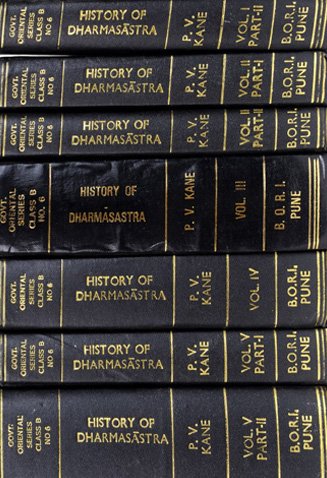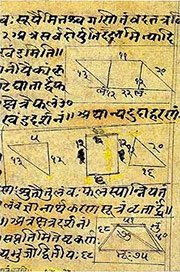Ayuta, Āyuta: 21 definitions
Introduction:
Ayuta means something in Buddhism, Pali, Hinduism, Sanskrit, Marathi. If you want to know the exact meaning, history, etymology or English translation of this term then check out the descriptions on this page. Add your comment or reference to a book if you want to contribute to this summary article.
In Hinduism
Purana and Itihasa (epic history)
Source: archive.org: Shiva Purana - English Translation1) Ayuta (अयुत) refers to a “thousand years of Brahmā” [?], according to the Śivapurāṇa 2.3.14 (“The Birth of Tāraka and Vajrāṅga”).—Accordingly, as Kaśyapa said to Diti: “Be pure and perform penance for ten thousand years of Brahmā [i.e., ayuta—brahmaṇaścāyutaṃ]. When it is completed you will have a son”.
2) Ayuta (अयुत) refers to “ten thousand” (sons of Dakṣa), according to the Śivapurāṇa 2.3.24 (“Śiva consents to marry Pārvatī”).—Accordingly, as the seven Sages said (with false words) to Pārvatī: “[...] Now listen to a true anecdote that sheds light thereon, with keen intellect. We are enlightening you out of love and affection, take it to heart. Dakṣa, the son of Brahmā, at the bidding of his father, begot ten thousand [i.e., ayuta] sons of his wife. He dearly loved them and employed them in performing a great penance. [...]
Source: Cologne Digital Sanskrit Dictionaries: The Purana Index1a) Ayuta (अयुत).—The son of Rādhika and father of Krodhana.*
- * Bha. IX. 22. 10-11.
1b) Ten thousand.*
- * Vāyu-purāṇa 101. 94.

The Purana (पुराण, purāṇas) refers to Sanskrit literature preserving ancient India’s vast cultural history, including historical legends, religious ceremonies, various arts and sciences. The eighteen mahapuranas total over 400,000 shlokas (metrical couplets) and date to at least several centuries BCE.
Dharmashastra (religious law)
Source: Sacred Texts: The Grihya Sutras, Part 2 (SBE30)Ayuta (अयुत) refers to “slightly melted butter”.—According to the Aitareya-Brāhmaṇa I, 3, “Ājya is sweet or fragrant to the gods, ghṛta to men, ayuta to the manes, navanīta to children”. Here the commentator explains that ājya is butter, when melted (vilīnaṃ sarpis), ghṛta, when hardened. Ayuta, sometimes called astu, is butter, when slightly melted, niṣpakva, when thoroughly melted.

Dharmashastra (धर्मशास्त्र, dharmaśāstra) contains the instructions (shastra) regarding religious conduct of livelihood (dharma), ceremonies, jurisprudence (study of law) and more. It is categorized as smriti, an important and authoritative selection of books dealing with the Hindu lifestyle.
Shaktism (Shakta philosophy)
Source: Brill: Śaivism and the Tantric Traditions (shaktism)Ayuta (अयुत) refers to a “millionth (part)”, according to the King Vatsarāja’s Pūjāstuti called the Kāmasiddhistuti (also Vāmakeśvarīstuti), guiding one through the worship of the Goddess Nityā.—Accordingly, “[...] The Vedas, independent scholars of different capabilities, the Tantras, the collection of mantras with celebrated powers, and thoughts and feelings concerning syntax and grammar and poetic compositions, all these, O mother, evolve to excellence from a millionth part of you (ayutāṃśa—tavāyutāṃśāt) ”.

Shakta (शाक्त, śākta) or Shaktism (śāktism) represents a tradition of Hinduism where the Goddess (Devi) is revered and worshipped. Shakta literature includes a range of scriptures, including various Agamas and Tantras, although its roots may be traced back to the Vedas.
Shaivism (Shaiva philosophy)
Source: Brill: Śaivism and the Tantric TraditionsAyuta (अयुत) refers to “millions (of suns)”, according to the 13th-century Matsyendrasaṃhitā: a Kubjikā-Tripurā oriented Tantric Yoga text of the Ṣaḍanvayaśāmbhava tradition from South India.—Accordingly, “[Visualisation of Parameśvara]:—In a hidden sanctuary, the mantra master should sit on a soft cushion and should visualise himself as having the body of Parameśvara, as if [he were transformed into] Kāmeśvara, having no beginning and no end, shining like millions of suns (sūrya-ayuta-samaprabha). [...] ”.

Shaiva (शैव, śaiva) or Shaivism (śaivism) represents a tradition of Hinduism worshiping Shiva as the supreme being. Closely related to Shaktism, Shaiva literature includes a range of scriptures, including Tantras, while the root of this tradition may be traced back to the ancient Vedas.
Ganitashastra (Mathematics and Algebra)
Source: archive.org: Hindu MathematicsAyuta (अयुत) refers to “ten-thousand” (10,000) in various lists of numeral denominations, according to gaṇita (“science of calculation”) and Gaṇita-śāstra, ancient Indian mathematics and astronomy.—We can definitely say that from the very earliest known times, ten has formed the basis of numeration in India. While the Greeks had no terminology for denominations above the myriad (104), and the Romans above the milk (103), the ancient Hindus dealt freely with no less than eighteen denominations [e.g., ayuta]. Cf. Yajurveda-saṃhitā (Vājasanyī) XVII.2; Taittirīya-saṃhitā IV.40.11, VII.2.20.1; Maitrāyaṇī-saṃhitā II.8.14; Kāṭhaka-saṃhitā XVII.10, XXXIX.6; Anuyogadvāra-sūtra 142; Āryabhaṭīya II.2; Triśatikā R.2-3; Gaṇitasārasaṃgraha I.63-68.

Ganitashastra (शिल्पशास्त्र, gaṇitaśāstra) refers to the ancient Indian science of mathematics, algebra, number theory, arithmetic, etc. Closely allied with astronomy, both were commonly taught and studied in universities, even since the 1st millennium BCE. Ganita-shastra also includes ritualistic math-books such as the Shulba-sutras.
In Buddhism
Mahayana (major branch of Buddhism)
Source: archive.org: Hindu Mathematics (Mahayana)Ayuta (अयुत) refers to a “billion” (1,000,000,000) in a list of numeral denominations, according to the Lalitavistara-sūtra, a well-known Buddhist work of the first century B.C.—Accordingly, “The mathematician Arjuna asked the Bodhisattva, ‘O young man, do you know the counting which goes beyond the koṭi on the centesimal scale? Bodhisattva: I know. Arjuna: How does the counting proceed beyond the koṭi on the centesimal scale? Bodhisattva: [hundred koṭis are called ayuta; hundred ayutas are called niyuta, ...]”.

Mahayana (महायान, mahāyāna) is a major branch of Buddhism focusing on the path of a Bodhisattva (spiritual aspirants/ enlightened beings). Extant literature is vast and primarely composed in the Sanskrit language. There are many sūtras of which some of the earliest are the various Prajñāpāramitā sūtras.
General definition (in Buddhism)
Source: Wisdom Library: BuddhismAyuta (अयुत) is the tenth of sixty digits (decimal place) in an special enumeration system mentioned by Vasubandhu in his Abhidharmakośa (“treasury of knowledge”). The explanations of the measure of years, eons, and so forth must be comprehended through calculation based on a numerical system. Enumeration begins from one and increases by a factor of ten for each shift in decimal place. The sixtieth number in this series is called “countless”.
Among these decimal positions (e.g., ayuta), the first nine positions from one to one hundred million are called ‘single set enumeration’. From a billion up to, but not including countless is “the enumeration of the great companion” and is called the ‘recurring enumeration’.
Languages of India and abroad
Pali-English dictionary
Source: Sutta: The Pali Text Society's Pali-English DictionaryĀyuta, (adj.) (Sk. ayuta, pp. of ā + yu, yuvati) — 1. connected with, endowed, furnished with Th. 1, 753 (dve pannaras’āyuta due to twice fifteen); Sn. 301 (nārī-varagaṇ° = °saṃyutta SnA 320); Pv. II, 124 (nānā-saragaṇ° = °yutta PvA. 157).—2. seized, conquered, in dur° hard to conquer, invincible J. VI, 271 (= paccatthikehi durāsada C.). (Page 106)

Pali is the language of the Tipiṭaka, which is the sacred canon of Theravāda Buddhism and contains much of the Buddha’s speech. Closeley related to Sanskrit, both languages are used interchangeably between religions.
Marathi-English dictionary
Source: DDSA: The Molesworth Marathi and English Dictionaryayuta (अयुत).—n S Ten thousand, a myriad.
Source: DDSA: The Aryabhusan school dictionary, Marathi-Englishayuta (अयुत).—n Ten thousand, a myriad.
Marathi is an Indo-European language having over 70 million native speakers people in (predominantly) Maharashtra India. Marathi, like many other Indo-Aryan languages, evolved from early forms of Prakrit, which itself is a subset of Sanskrit, one of the most ancient languages of the world.
Sanskrit dictionary
Source: DDSA: The practical Sanskrit-English dictionaryAyuta (अयुत).—a.
1) Disjoined, detached, not connected.
2) Uninterrupted, undisturbed. Av.19.51.1.
-tam Ten thousand, a myriad. सूर्याब्धिसंख्यया द्वित्रिसागरैरयुताहतैः (sūryābdhisaṃkhyayā dvitrisāgarairayutāhataiḥ) Sūrya. शाखानामयुतम् (śākhānāmayutam)
--- OR ---
Āyuta (आयुत).—a.
1) Mixed, mingled.
2) Melted.
-tam Half-melted butter.
Source: Cologne Digital Sanskrit Dictionaries: Edgerton Buddhist Hybrid Sanskrit DictionaryAyuta (अयुत).—nt. (m. in Sanskrit only Mahābhārata Crit. ed. 3.21.24; in [Buddhist Hybrid Sanskrit] noted as m. Mahāvyutpatti 7998), in Sanskrit only defined as 10,000; so also Mahāvyutpatti 8054 = Tibetan khri; but oftener = 100 koṭis or 1,000,000,000 = Tibetan ther ḥbum, so defined Lalitavistara 147.20 (cited Mahāvyutpatti 7955), also Mahāvyutpatti 7998, and presumably also 7701, 7827 (in these at least higher than koṭi, and between this and niyuta); in Sukhāvatīvyūha 31.1 a very much higher number, listed between nayuta and akṣobhya.
Source: Cologne Digital Sanskrit Dictionaries: Shabda-Sagara Sanskrit-English DictionaryAyuta (अयुत).—mfn.
(-taḥ-tā-taṃ) Disjoined, detached. n.
(-taṃ) Ten thousand. E. a neg. and yuta joined, counted.
Source: Cologne Digital Sanskrit Dictionaries: Cappeller Sanskrit-English DictionaryAyuta (अयुत).—1. [adjective] unrestrained.
--- OR ---
Ayuta (अयुत).—2. [masculine] [neuter] a myriad; [adverb] śas†.
--- OR ---
Āyuta (आयुत).—[adjective] connected or endowed with (—°).
Source: Cologne Digital Sanskrit Dictionaries: Monier-Williams Sanskrit-English Dictionary1) Ayuta (अयुत):—[=a-yuta] 1. a-yuta mfn. (√1. yu), unimpeded, [Atharva-veda xix, 51, 1]
2) [v.s. ...] Name of a son of Rādhika, [Bhāgavata-purāṇa]
3) [=a-yuta] 2 n. ([as m. only, [Mahābhārata iii, 801]]), ‘unjoined, unbounded’, ten thousand, a myriad, [Ṛg-veda; Atharva-veda etc.]
4) [v.s. ...] in [compound] a term of praise (See ayutādhyāpaka), ([gana] kāṣṭhādi q.v.)
5) Āyuta (आयुत):—[=ā-yuta] [from ā-yu] mfn. melted, mixed, mingled
6) [v.s. ...] ifc. combined with, [Mahābhārata; Rāmāyaṇa; Bhāgavata-purāṇa]
7) [v.s. ...] n. (ā-yutam) half-melted butter, [Maitrāyaṇī-saṃhitā; Aitareya-brāhmaṇa]
Source: Cologne Digital Sanskrit Dictionaries: Yates Sanskrit-English DictionaryAyuta (अयुत):—(taṃ) 1. n. Ten thousand. a. Apart, disjoined.
Source: DDSA: Paia-sadda-mahannavo; a comprehensive Prakrit Hindi dictionary (S)Ayuta (अयुत) in the Sanskrit language is related to the Prakrit words: Aua, Ajua.
[Sanskrit to German]
Sanskrit, also spelled संस्कृतम् (saṃskṛtam), is an ancient language of India commonly seen as the grandmother of the Indo-European language family (even English!). Closely allied with Prakrit and Pali, Sanskrit is more exhaustive in both grammar and terms and has the most extensive collection of literature in the world, greatly surpassing its sister-languages Greek and Latin.
Kannada-English dictionary
Source: Alar: Kannada-English corpusAyuta (ಅಯುತ):—
1) [adjective] disjoined; detached; not connected.
2) [adjective] not coming for consideration; kept out of serious reckoning.
--- OR ---
Ayuta (ಅಯುತ):—[adjective] amounting to ten thousand.
--- OR ---
Ayuta (ಅಯುತ):—[noun] the cardinal number ten thousand; a myriad.
Kannada is a Dravidian language (as opposed to the Indo-European language family) mainly spoken in the southwestern region of India.
See also (Relevant definitions)
Starts with (+7): Ayutacalai, Ayutadha, Ayutadhara, Ayutadhyapaka, Ayutahoma, Ayutahomalakshahomakotihoma, Ayutahomavidhana, Ayutahomavidhi, Ayutajit, Ayutam, Ayutamsha, Ayutanayi, Ayutanayin, Ayutanayin, Ayutanga, Ayutaniyuta, Ayutaparitcai, Ayutaprayuta, Ayutapucai, Ayutashas.
Ends with (+54): Adhikarayuta, Aprayuta, Arshomrogayuta, Arshorogayuta, Arthayuta, Asamayuta, Audaryayuta, Avayuta, Ayutaprayuta, Badishayuta, Balayuta, Bhujagabhogayuta, Calayuta, Chikka chiraayuta, Chikka-chiraayuta, Chikka-chirayuta, Daivayuta, Danayuta, Dhairyayuta, Dharmayuta.
Full-text (+44): Ayutashas, Nayin, Ayutanayin, Ayutam, Ayutajit, Ayutahoma, Ayutasiddhi, Samayuta, Ayutasiddha, Ayutadhyapaka, Varshayuta, Ayutashva, Krodhana, Ayutadha, Ayutadhara, Mahayuta, Eriyayutam, Velayutam, Turayutam, Niyuta.
Relevant text
Search found 33 books and stories containing Ayuta, A-yuta, Ā-yuta, Āyuta; (plurals include: Ayutas, yutas, Āyutas). You can also click to the full overview containing English textual excerpts. Below are direct links for the most relevant articles:
Garga Samhita (English) (by Danavir Goswami)
Verse 1.6.15 < [Chapter 6 - Description of Kaṃsa’s Strength]
Verse 6.9.19 < [Chapter 9 - The Arrival of Śrī Dvārakā]
Verse 1.10.17 < [Chapter 10 - Description of the Birth of Lord Balarāma]
Rig Veda (translation and commentary) (by H. H. Wilson)
Rig Veda 4.26.7 < [Sukta 26]
The Garuda Purana (by Manmatha Nath Dutt)
Chapter XXXVII - Description of the glories of Gayatri < [Agastya Samhita]
Chapter LVI - Enumeration of the names of princes of the continent of Plaksha, etc. < [Agastya Samhita]
Apastamba Yajna-paribhasa-sutras (by Hermann Oldenberg)
The Devi Bhagavata Purana (by Swami Vijñanananda)
Chapter 18 - On the narrative of Rāhu Maṇḍalam < [Book 8]
Chapter 29 - On the anecdote of Sāvitrī, on gifts and on the effects of Karmas < [Book 9]
Chapter 30 - On the conversation between Sāvitrī and Yama and on the fruition of Karmas < [Book 9]
The Practice Manual of Noble Tārā Kurukullā (by Dharmachakra Translation Committee)
Chapter 4 < [Appendix - Sanskrit Text]
Related products

